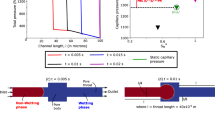Abstract
Capillary channel techniques with free liquid surfaces provide very reliable means for liquid management in space. However, capillary channel flow is subject to limitation due to liquid surface instabilities when a critical flow rate is reached. Steady flow rate limitation is a consequence of the choking effect and well understood. Critical steady flow rate computation with a one-dimensional model is related to a numerical singularity which occurs at critical flow. For transient flow the singularity does not occur. Therefore, a new transient stability model is defined. It is based on the steady model, a simplified transient momentum balance, the consideration of the capillary pressure of typical observed surface shapes, and on a simplified dynamic inside the channel. The balance and dynamic are defined by liquid and geometrical properties only and therefore significantly easier to compute than a transient differential equation system. In 2011, experiments were performed in cooperation with NASA on the International Space Station (ISS) to confirm the model for steady flow and validate the new transient model. A new phenomenon is discussed, the flexibility effect, which provides significant additional transient stability for channels of sufficient length. An undesired feedback effect, provoked by the reuse of the liquid in a circular loop of the experimental setup, and which influenced the measurements, is compensated by a semi-empirical model for a feedback ratio.











Similar content being viewed by others
References
Canfield, P.J., Bronowicki, P.M., Chen, Y., Kiewidt, L., Grah, A., Klatte, J., Jenson, R., Blackmore, W., Weislogel, M.M., Dreyer, M.E.: The Capillary Channel Flow experiments on the International Space Station, Experiment setup and first results. Exp. Fluids 54, 1–14 (2013). doi:10.1007/s00348-013-1519-1
Dreyer, M.E., Delgado, A., Rath, H.J.: Capillary rise of liquid between parallel plates under microgravity. J. Colloid Interf. Sci. 163, 158–168 (1994)
Gilmore, D.G.: Satellite Thermal Control Handbook. The Aerospace Corporation, El Segundo (1994)
Grah, A., Haake, D., Rosendahl, U., Klatte, J., Dreyer, M.E.: Stability limits of unsteady open capillary channel flow. J. Fluid Mech. 600, 271–289 (2008)
Grah, A., Dreyer, M.E.: Dynamic stability analysis for capillary channel flow: one-dimensional and three-dimensional computations and the Equivalent Steady State technique. Phys. Fluids 22–014101 (2010)
Jaekle, D. E. Jr.: Propellant management device conceptual design and analysis: vanes. AIAA Paper 91–2172, 1–13 (1991)
Kostner, J.N., Sani, R.L.: Low-Gravity Fluid Dynamics and Transport Phenomena. American Institute of Aeronautics and Astronautics, Washington (1990)
Landau, L.D., Lifschitz, E.M.: Course of Theoretical Physics, vol. 6. Pergamon Press, Oxford (1959)
Lighthill, J., 3rd: Waves in Fluids. Cambridge University Press (1978)
OpenFOAM: user guide version 2.0 (2011)
Rollins, J.R., Grove, R.K., Jaekle Jr. D.E.: Twenty-three years of surface tension propellant management system design, development, manufacture, test and operation. AIAA Paper l (1985)
Rosendahl, U., Ohlhoff, A., Dreyer, M.E., Rath, H.J.: Convective dominated flows in open capillary channels. Microgravity Sci. Technol. 4, 53–59 (2002)
Rosendahl, U., Ohlhoff, A., Dreyer, M.E.: Choked flows in open capillary channels: theory, experiment and computations. J. Fluid Mech. 518, 187–214 (2004)
Rosendahl, U., Dreyer, M.E.: Design and performance of an experiment for the investigation of open capillary channel flows. Exp. Fluids 42, 683–696 (2007)
Rosendahl, U., Grah, A., Dreyer, M.E.: Convective dominated flows in open capillary channels. Phys. Fluids 22–052102 (2010)
Salim, A., Colin, C., Grah, A., Dreyer, M.E.: Laminar bubbly flow in an open capillary channel in microgravity. Int. J. Multiphas. Flow 36, 707–719 (2010)
Shapiro, A.H.: The dynamics and thermodynamics of compressible fluid flow, vol. II. Ronald Press (1953)
Shapiro, A.H.: Steady flow in collapsible tubes. J. Biomech. Eng. 99, 126–147 (1977)
Sparrow, E.M., Lin, S.H., Lundgren, T.S.: Flow development in the hydrodynamic entrance region of tubes and ducts. Phys. Fluids 7(3), 338–347 (1964)
Srinivasan, R.: Estimating zero-g flow rates in open channels having capillary pumped vanes. Int. J. Numer. Meth. Fluids 41, 389–417 (2003)
White, F: Fluid mechanics. McGraw Hill (1986)
Wilson, T.A., Rodarte, J.R., Butler, J.P.: Wave speed and viscous flow limitation, Handbook of Physiology. American Physiological Society (1986)
Acknowledgments
The authors would like to acknowledge the support provided by the NASA employees at Marshall Space Flight Centre. We thank NASA astronauts Scott Kelly, Catherine Coleman, and Mike Fossum, who installed and removed the experiment hardware on board the ISS. We also acknowledge the technical staff at Astrium for manufacturing the experiment hardware and for technical support during the experiments. And we thank Lars Kiewidt, R. Jenson, and W. Blackmore for the help during the CCF experiment.
This experiment is realized in cooperation between NASA and the German Aerospace Center (DLR). The project is supported by the DLR through funds from the German Federal Ministry of Economics and Technology (BMWi) under grant numbers 50WM0535/0845/1145.
Author information
Authors and Affiliations
Corresponding author
Rights and permissions
About this article
Cite this article
Grah, A., Canfield, P.J., Bronowicki, P.M. et al. Transient Capillary Channel Flow Stability. Microgravity Sci. Technol. 26, 385–396 (2014). https://doi.org/10.1007/s12217-014-9403-z
Received:
Accepted:
Published:
Issue Date:
DOI: https://doi.org/10.1007/s12217-014-9403-z




